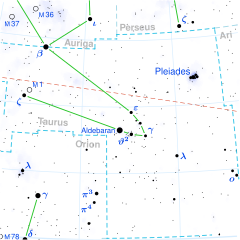Upsilon Tauri
| Observation data Epoch J2000.0 Equinox J2000.0 (ICRS) | |
|---|---|
| Constellation | Taurus |
| Right ascension | 04h 26m 18.46368s[1] |
| Declination | +22° 48′ 48.8885″[1] |
| Apparent magnitude (V) | 4.28 – 4.31[2] |
| Characteristics | |
| Spectral type | A8 Vn[3] |
| U−B color index | +0.14[4] |
| B−V color index | +0.25[4] |
| Variable type | δ Scuti[2] |
| Astrometry | |
| Radial velocity (Rv) | 32.2±1.1[5] km/s |
| Proper motion (μ) | RA: +108.81[1] mas/yr Dec.: −46.80[1] mas/yr |
| Parallax (π) | 21.21 ± 0.25 mas[1] |
| Distance | 154 ± 2 ly (47.1 ± 0.6 pc) |
| Absolute magnitude (MV) | +0.91[6] |
| Details | |
| Mass | 1.55[7] M☉ |
| Radius | 1.803[8] R☉ |
| Luminosity | 32.5[9] L☉ |
| Surface gravity (log g) | 3.50[7] cgs |
| Temperature | 7,398±252[7] K |
| Rotation | 0.415 d[8] |
| Rotational velocity (v sin i) | 243[3] km/s |
| Age | 827[7] Myr |
| Other designations | |
| Database references | |
| SIMBAD | data |
Upsilon Tauri (υ Tauri) is a solitary,[11] white-hued star in the zodiac constellation of Taurus, and is a member of the Hyades star cluster.[8] It is faintly visible to the naked eye with an apparent visual magnitude of +4.3. Based upon an annual parallax shift of 21.21 mas seen from Earth, it is around 154 light years from the Sun.
Properties
[edit]
This is an A-type main sequence star with a stellar classification of A8 Vn.[3] It is classified as a Delta Scuti type variable star and its brightness varies from magnitude +4.28 to +4.31 with a period of 3.56 hours.[2] At an estimated age of 827 million years,[7] it is spinning rapidly with a rotation period of just 0.415 days.[8] This is giving the star an oblate shape with an equatorial bulge that is 9% larger than the polar radius.[13]
Occasionally this star system shares the Bayer designation υ Tauri with 72 Tauri, which is separated from it by 0.29° in the sky.[14]
Naming
[edit]With φ, κ1, κ2 and χ, it composed the Arabic were the Arabs' Al Kalbain, the Two Dogs.[15] According to the catalogue of stars in the Technical Memorandum 33-507 - A Reduced Star Catalog Containing 537 Named Stars, Al Kalbain were the title for five stars : φ as Alkalbain I, χ as Alkalbain II, κ1 as Alkalbain III, κ2 as Alkalbain IV and this star (υ) as Alkalbain V.[16]
References
[edit]- ^ a b c d e van Leeuwen, F. (2007), "Validation of the new Hipparcos reduction", Astronomy and Astrophysics, 474 (2): 653–664, arXiv:0708.1752, Bibcode:2007A&A...474..653V, doi:10.1051/0004-6361:20078357, S2CID 18759600.
- ^ a b c Samus, N. N.; et al. (2017), "General Catalogue of Variable Stars", Astronomy Reports, 5.1, 61 (1): 80–88, Bibcode:2017ARep...61...80S, doi:10.1134/S1063772917010085, S2CID 125853869.
- ^ a b c Royer, F.; et al. (February 2007), "Rotational velocities of A-type stars. III. Velocity distributions", Astronomy and Astrophysics, 463 (2): 671–682, arXiv:astro-ph/0610785, Bibcode:2007A&A...463..671R, doi:10.1051/0004-6361:20065224, S2CID 18475298.
- ^ a b Danziger, I. J.; Dickens, R. J. (July 1967), "Spectrophotometry of New Short-Period Variable Stars", Astrophysical Journal, 149: 55, Bibcode:1967ApJ...149...55D, doi:10.1086/149231.
- ^ de Bruijne, J. H. J.; Eilers, A.-C. (October 2012), "Radial velocities for the HIPPARCOS-Gaia Hundred-Thousand-Proper-Motion project", Astronomy & Astrophysics, 546: 14, arXiv:1208.3048, Bibcode:2012A&A...546A..61D, doi:10.1051/0004-6361/201219219, S2CID 59451347, A61.
- ^ Anderson, E.; Francis, Ch. (2012), "XHIP: An extended hipparcos compilation", Astronomy Letters, 38 (5): 331, arXiv:1108.4971, Bibcode:2012AstL...38..331A, doi:10.1134/S1063773712050015, S2CID 119257644.
- ^ a b c d e David, Trevor J.; Hillenbrand, Lynne A. (2015), "The Ages of Early-Type Stars: Strömgren Photometric Methods Calibrated, Validated, Tested, and Applied to Hosts and Prospective Hosts of Directly Imaged Exoplanets", The Astrophysical Journal, 804 (2): 146, arXiv:1501.03154, Bibcode:2015ApJ...804..146D, doi:10.1088/0004-637X/804/2/146, S2CID 33401607.
- ^ a b c d van Saders, Jennifer L.; Pinsonneault, Marc H. (October 2013), "Fast Star, Slow Star; Old Star, Young Star: Subgiant Rotation as a Population and Stellar Physics Diagnostic", The Astrophysical Journal, 776 (2): 20, arXiv:1306.3701, Bibcode:2013ApJ...776...67V, doi:10.1088/0004-637X/776/2/67, S2CID 119097746, 67.
- ^ McDonald, I.; et al. (2012), "Fundamental Parameters and Infrared Excesses of Hipparcos Stars", Monthly Notices of the Royal Astronomical Society, 427 (1): 343–57, arXiv:1208.2037, Bibcode:2012MNRAS.427..343M, doi:10.1111/j.1365-2966.2012.21873.x, S2CID 118665352.
- ^ "ups Tau", SIMBAD, Centre de données astronomiques de Strasbourg, retrieved 2017-08-05.
- ^ Eggleton, P. P.; Tokovinin, A. A. (September 2008), "A catalogue of multiplicity among bright stellar systems", Monthly Notices of the Royal Astronomical Society, 389 (2): 869–879, arXiv:0806.2878, Bibcode:2008MNRAS.389..869E, doi:10.1111/j.1365-2966.2008.13596.x, S2CID 14878976.
- ^ MAST: Barbara A. Mikulski Archive for Space Telescopes, Space Telescope Science Institute, retrieved 8 December 2021.
- ^ van Belle, Gerard T. (March 2012), "Interferometric observations of rapidly rotating stars", The Astronomy and Astrophysics Review, 20 (1): 51, arXiv:1204.2572, Bibcode:2012A&ARv..20...51V, doi:10.1007/s00159-012-0051-2, S2CID 119273474.
- ^ Hoffleit, D.; Jaschek, C. (1991), The Bright Star Catalogue, New Haven: Yale University Observatory, Bibcode:1991bsc..book.....H.
- ^ Allen, Richard Hinckley (1899), Star-Names and Their Meanings, New York: G. E. Stechert, p. 413
- ^ Rhoads, Jack W. (November 15, 1971), Technical Memorandum 33-507-A Reduced Star Catalog Containing 537 Named Stars (PDF), Jet Propulsion Laboratory, California Institute of Technology.

